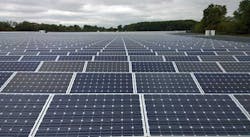Hybrid Microgrids Help Data Centers Achieve Net-Zero Goals
We’ve witnessed some tremendous strides in recent years, including decarbonization and sustainability commitments from grid operators and large commercial entities. We’ve also incorporated more renewables in many markets, with upwards of 35% of the energy mix coming from solar, wind and hydro generation.
However, progress in the name of sustainability often overlooks one critical factor: resiliency. As our society focuses on sustainability, we need to expand our definition of the term “sustainable” to mean both sustainably sourced power, along with sustainable (i.e., resilient) power availability for all human society. This thinking will help us avoid the kinds of disasters we’ve seen recently with Winter Storm Uri in Texas and heat storms in California and the West.
When we evaluate current thinking and common approaches, we see a rational combination of renewables and battery storage. This great short-duration solution leverages renewables and shifts a day’s solar or wind production into the evening hours of peak demand. However, batteries do not offer long-duration options beyond four or eight hours, are expensive and are not considered good resiliency options. And since wind and solar power are dependent upon the sun shining and the wind blowing, we have a need for a longer-term resiliency solution.
How do we strike the right balance of carbon neutrality and renewables adoption with low-emission resiliency solutions that back this up?
The answer is hybrid microgrids. A hybrid solution for backup generation – a microgrid – consists of a combination of renewables, battery storage and highly resilient natural gas or renewable natural gas (RNG) generation. Ideally, we deploy dual-purpose microgrids that both support commercial customer’s long duration resiliency requirements along with services that support underlying grid stability and accommodate additional renewable generation. This hybrid approach enables us to protect communities while preserving the planet’s long-term viability.
What is exciting is that we can implement this technology today. However, it will require disruptive new thinking, a willingness to forego the status quo, and collective work to prioritize this new approach to clean, resilient grid solutions. These innovative steps and investments will help the United States become a global leader in our successful path to the net-zero economy.
Some key steps need to occur to achieve the proper momentum so we can get there. For starters, corporate and commercial entities must continue to push hard to attain an improved mix of green energy sources. The largest commercial and industrial power consumers should continue to think differently and be willing to re-evaluate the status quo of blind dependency on diesel generators for local resiliency. Organizations such as water treatment facilities, data center providers, and large-scale manufacturers and distributers — sites that often have 10 megawatts to over 100 megawatts — need to lead this charge.
Data center and hyperscale providers can shape this future. Many of these large power consumers have corporate objectives of carbon neutrality (even carbon negative) but find themselves having to achieve this through buying carbon credits to offset their carbon output. You’ll often hear this referred to as “creative carbon accounting,” and it’s called out in many regions. Many of these facilities still operate large footprints of diesel backup generators to maintain emergency backup power. As these organizations design and build new facilities, a concerted effort should be made to evaluate alternative approaches, like RNG microgrids that can provide similar back-up performance with improved emissions and lower overall cost.
It’s also critical that our public sectors legislate to drive change and make organizations rationalize why they’re unwilling to evaluate alternative, cleaner solutions. Two organizations in California, the California Energy Commission and California Air Resources Board are examples of how public policy can influence commercial organizations. They have made it more difficult for data center providers to get the necessary permitting to complete their data center builds if they choose to use diesel generators. The more red tape and longer the delay, the more difficult it is for the operator as they strand capital (e.g., a partially built data center) and delay the return on investment for its shareholders. This additional financial pressure is driving innovative data centers operators to explore alternative solutions, such as RNG microgrids, for their back-up systems.
In short, it’s time for all of us to “get real” about what does not work anymore and what can work right now to move us down the path of energy transition. We can continue to progress our society and be a global climate change leader with cooperation across businesses and government to embrace renewables, battery storage, and resilient RNG microgrids. In the future, technology and chemistry will hopefully come together to provide longer duration storage options of hopefully 5 days or more. But in the near and mid-term, as we bridge to a net-zero economy, a hybrid solution that incorporates the benefits of renewables and battery storage with the resiliency of natural gas or RNG microgrids is the right balanced approach to achieve carbon neutrality now and underlying grid resiliency.
In the world of energy transition, this hybrid microgrid solution allows all of society to metaphorically, have our cake and eat it too.
John Gould is a data center veteran and Chief Revenue Officer of Enchanted Rock. He’s responsible for scaling Enchanted Rock’s commercial and industrial operations. Enchanted Rock provides fully-managed clean microgrids designed for fast, simple, and worry-free protection from extended power outages. To learn more about hybrid microgrids for data centers – get the report


